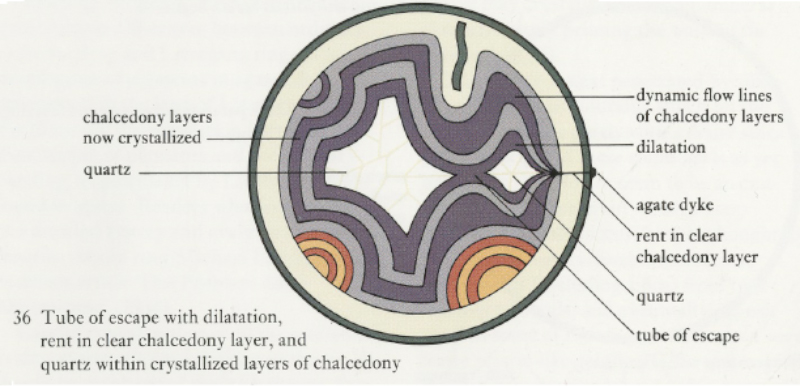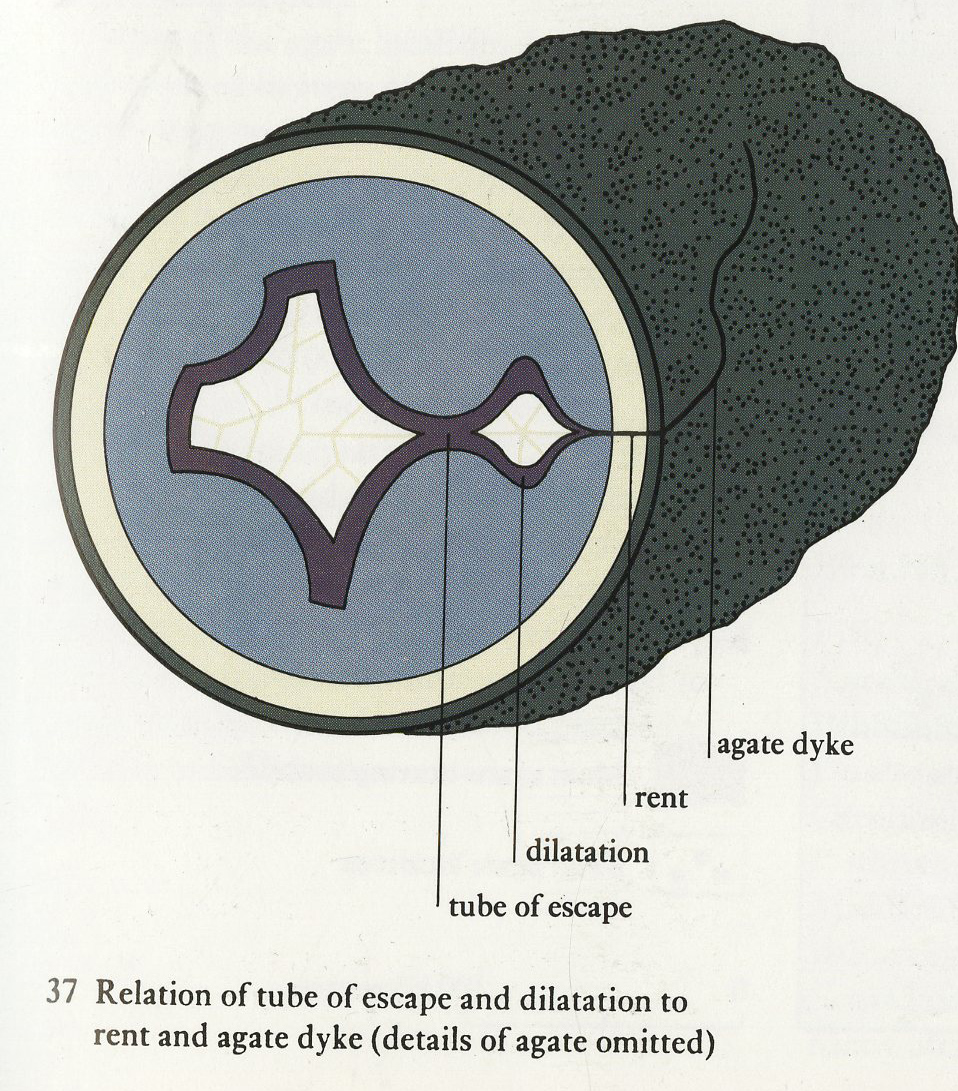The theory begins with an empty gas cavity which, for convenience, shall be taken to be spherical, so yielding a central cross-section which is circular in outline. The cavity is usually first lined with a green mineral skin which consist of one or more silicate minerals such as celadonite, chlorite and saponite. This skin is formed as a result of the movement of meteoric waters (that is mainly water that has percolated downwards into rocks) through lava "here it decomposes some of the constituent minerals and carries away from them certain chemical elements in solution. Some of the leached substances are deposited in gas cavities where they crystallize as a green mineral skin, effectively priming the walls of the vesicles.
The vesicle is then penetrated by silica-bearing colloidal solutions which fill the vesicle wholly or partly with a dense silica gel. The origin of these solutions is as yet unknown: they do not seem to be an end-product of volcanism in which watery solutions typically occur, but are thought to be meteoric water. Such waters leach constituents (including silica) from rock-forming minerals, and eventually deposit them in some of the empty vesicles as a very dense plastic-like gel. In some agates the skin gets ruptured during this stage and fragments of it may hang down into the gel. This gel, composed mainly of silica with some water and impurities, is now contained in its own unique space. It is destined to increase even more in density until it reaches a crystalline state, a process beginning with the separation or segregation of its constituents into layers through a process of chemical differentiation and diffusion. It is these different layers which will crystallize as varieties of quartz. Each layer has its own composition of silica, water (sometimes there is none) and impurities such as pigmenting iron compounds.
The segregated hydrous and anhydrous silica bands enclosed by the solid clear chalcedony layer may now progress to crystallization without the bands being distorted from a natural configuration within the vesicle, or the bands may be affected by dynamic forces arising within the vesicle. The nature of these forces is as yet unkown; they may be associated with shrinkage, expansion, initial growth, differences in super-saturation levels or other factors. Though the precise nature of these forces cannot be specified, we should not be deterred from recognizing that such forces must exist. The evidence lies in the obvious distortion of visible bands in some agates. In general, agates whose bands are distorted by forces prior to their crystallization will show marked irregularity in the course of their banding, with the possible formation of tubes of escape and dilatations (fig 36).
In some agates the dynamic forces are so intense that they cannot be relieved simply be creating tubes of escape and dilatations. Only when the clear chalcedony layer is actually torn by pressure from the tubes and/or dilatations is relief obtained. When this happens, a small amount of silica gel is expelled through the rent giving rise to the minutely raised features here called agate dykes(fig 37). Thus, depending on the nature of the containment forces, some nascent agates may show deformed banding.
Every agate is unique even though the rock environment is the same as regards pressure, temperature, and meteoric water compositions. Agates of totally different kinds and colours can grow side by side, each in its own unique and idiosyncratic abode. Only when the silica bands have evolved to a state of near crystallization does crystallization proper begin. Fibrous chalcedony mixed with some fine granular quartz crystallizes as tiny growth bands, extending from the clear chalcedony layer towards the centre of the agate, and as it does so it divides the agate into sector zones. These growth bands and sector zones can be seen clearly under a microscope.
Coloured bands in agate, despite their often striking appearance, are due to chance variations in pigment distribution. The pigments, the commonest of which are iron compounds, such as iron oxide, come mainly from the impurities mentioned above. Colour bands are also much broader than growth bands, and such broad bands do not mark separate growth stages or layers of crystallization within agates.


